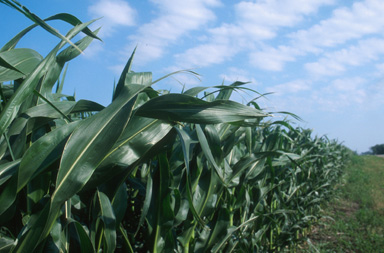
Agricultural News
New Report Finds That Agricultural Innovation Benefits National Economy
Tue, 08 Nov 2011 12:51:31 CST
 The use of crop protection products, including insecticides, herbicides and fungicides, helps U.S. agriculture to remain a key economic driver, according to a new report released today by CropLife America (CLA). Using the resources of economists and agricultural sources within the U.S. government, agronomist Mark Goodwin (Mark Goodwin Consulting Ltd.) authored the new report, titled "The Contribution of Crop Protection Products to the U.S. Economy," in conjunction with CLA, the national trade association representing the manufacturers, formulators and distributors of plant science technologies. The report reveals that across the U.S., the increased crop production and resultant economic spin-offs that stem from the use of crop protection products generate $33 billion in wages for over 1.05 million American workers. These jobs span beyond the farming industry to additional sectors, including manufacturing, food services, construction, transportation and more.
The use of crop protection products, including insecticides, herbicides and fungicides, helps U.S. agriculture to remain a key economic driver, according to a new report released today by CropLife America (CLA). Using the resources of economists and agricultural sources within the U.S. government, agronomist Mark Goodwin (Mark Goodwin Consulting Ltd.) authored the new report, titled "The Contribution of Crop Protection Products to the U.S. Economy," in conjunction with CLA, the national trade association representing the manufacturers, formulators and distributors of plant science technologies. The report reveals that across the U.S., the increased crop production and resultant economic spin-offs that stem from the use of crop protection products generate $33 billion in wages for over 1.05 million American workers. These jobs span beyond the farming industry to additional sectors, including manufacturing, food services, construction, transportation and more.
"While America continues to recover from overall staggering economic challenges and high unemployment levels, our farmers and ranchers stand poised as an important part of the solution," said Jay Vroom, president and CEO of CLA. "This report finds that when equipped with the best tools and resources, the agricultural community helps create well-paying jobs in the workplace through increased productivity and crop output. As such, it is more important than ever that we establish sound policy that allows U.S. agriculture to thrive, and allows for the continued innovation and investment in the crop protection industry."
Data from the report finds that while every state received a positive economic spin-off from the use of crop protection products, nine states can each count 30,000 or more full-time employee equivalents that exist owing to the spin-off benefits of the additional crop produced as a result of crop protection product usage. The top four are California, Florida, Minnesota and Washington. The impacts from the use of crop protection technologies account for the creation of 256,794 jobs in California, 80,803 in Florida, 45,437 in Minnesota, and 64,274 in Washington. Total salaries for the incremental jobs at the four states annually reach $9.8 billion, $2.0 billion, $1.7 billion and $1.9 billion, respectively.
The spin-off job creation is due directly to the economic activity that is powered by increased crop yields that arrive from the use of pest control products. Crop protection products add increased yield and quality of field crops, nut/fruit crops and vegetables to the extent that they add $51.4 billion, $18.9 billion and $11.5 billion respectively in crop value. As the annual value of farm production exported from the U.S. averaged approximately $100 billion in recent years, a significant portion this export value can be attributed to the use of crop protection products.
The report also found that crop inputs play a direct role in helping to keep food prices low, all the way to the grocery story. Plant science technologies lead to a 48 percent savings in overall grocery bills for fruits and vegetables for a family of four in the U.S.
"Another key component of modern U.S. agriculture is that it allows for an abundant supply of safe and affordable food, and with the global population now reaching 7 billion, this goal is more important than ever," continued Vroom. "While crop protection technologies help to increase yields and lead to broader spin-off effects, it also allows for lower food prices and for consumers have increased access to an affordable and nutritious meal."
Finally, the report looked at the spin-off environmental impact of crop protection products, and found that crop inputs allow farmers to conserve land by maximizing their current fields and to engage in modern practices such as conservation tillage. U.S. farmers now produce four times as much field crops (wheat and corn) as they did in the early 1900's while keeping millions of acres for wildlife habitats. Due to conservation tillage, made possible through the use of herbicides, growers have saved 558 million gallons of fuel per year, equaling 2.075 billion pounds of carbon dioxide emissions.
Click here to download a copy of the report.
WebReadyTM Powered by WireReady® NSI
Top Agricultural News
More Headlines...




















